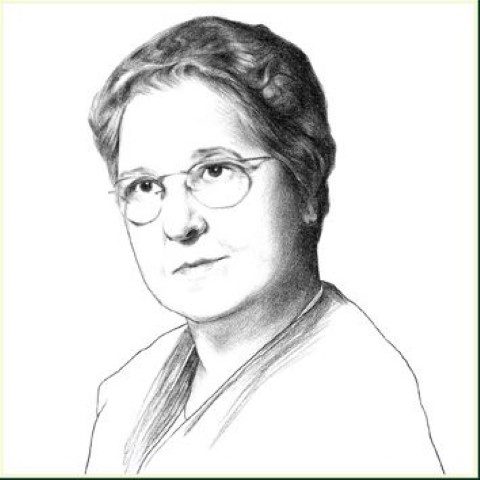William Leeming
Canada
 |
| Madge Thurlow Macklin |
Most histories on the subject say that the name “medical genetics” was coined in 1932 by Madge Thurlow Macklin.1 But as it so happens, the term first appears in a book by the English polymath Lancelot Hogben, Genetic Principles in Medicine and Social Science: “Whatever views one may entertain concerning the urgency of social policies based on genetic assumptions, the urgency of promptitude in developing the machinery of research in medical genetics should not be overlooked by any who have the advancement of pure science at heart.”2
Macklin, nonetheless, is important for her efforts to introduce genetics instruction into medical education.3 In 1932 she corresponded with several deans of medical schools in Canada, the United States, and Britain, inquiring about the amount of instruction they were providing on heredity and disease. She presented her findings at the Third International Eugenics Congress held in New York during August 1932 as part of a proposal that a standardized course in medical genetics be established during the last year of medical school. Macklin went on to prepare a sample syllabus for such a course in 1933. She proposed thirty-six hours of instruction, including two hours devoted to the basic principles of Mendelian genetics, one hour of methodology for compiling family histories, and one hour of “preventive and public health aspects of the problem.”
Macklin’s writings on hereditary disease began with two articles in 1926: a segregation analysis of eye color in children that showed brown dominant to blue coloration, consistent with the segregation of a Mendelian character, and a second article on work done by Maude Slye, Director of the Cancer Laboratory at the University of Chicago, who held the belief that cancer was a hereditary recessive trait that could be eliminated through selective breeding. A third article, co-authored with J. Thornley Bowman in 1926, looked at peroneal muscular atrophy. These articles were followed in 1927 with a series of articles in the Canadian Medical Association Journal that provided an overview on principles of Mendelian heredity as evidenced by different disorders of the eye. In 1935, in a massive review article on the role of heredity in clinical phenomena, she presented an impressive list of 200 heritable diseases and discussions of twin studies, consanguineous marriage, family pedigrees, and statistical techniques.
She was born in Philadelphia, the fourth of five children of Margaret (née De Grofft) and William Harrison Thurlow, an engineer.4 She received a fellowship to study physiology at Johns Hopkins Medical School in 1914-1915, and then entered the medical program. In 1918, she married Dr. Charles C. Macklin, associate professor of anatomy at Hopkins. In 1921 the Macklin family, including two children, moved to Canada, where Charles Macklin was appointed professor of histology and embryology at the University of Western Ontario. The total full-time complement of the faculty of medicine in the 1920s at the university was about ten, and all were appointed to basic science disciplines rather than the medical school. Madge Macklin received a part-time appointment as instructor in the same department as her husband. She continued in this position for the next fifteen years until 1945, when her teaching appointment was terminated. She went on to become cancer research associate at Ohio State University in 1946. The following year she took over a course on medical genetics first created by Laurence Snyder, a Harvard-trained geneticist, as part of the medical school curriculum at Ohio State in 1933.5 Macklin and Snyder had been on the lecture circuit and cited one another’s views, especially where the topic of genetics instruction and medical education was concerned. In 1942, Macklin was the first woman to give the Gibson Memorial Lecture at the University of Buffalo, and in 1957 she was awarded the Elizabeth Blackwell Medal of the American Medical Women’s Association. In 1959, the year she retired, she was elected president of the American Society for Human Genetics.
Notes
- See, for example: McLaren, A. Our Own Master Race: Eugenics in Canada 1885‑1945. Toronto: McClelland and Stewart; 1990, Soltan, HC. Medical Genetics in Canada. Evolution of a Hybrid Discipline: Essays on the Early History. London, ON: University of Western Ontario Regional Medical Genetics Centre; 1992, Harper, P. A Short History of Medical Genetics. Oxford: Oxford University Press; 2008.
- Hogben, L. Genetic Principles in Medicine and Social Science. London: Williams and Norgate; 1931, 214.
- Leeming, W. Tracing the Shifting Sands of “Medical Genetics”: What’s in a Name? Studies in History and Philosophy of Biological and Biomedical Sciences. 2010; 41: 50-60.
- Soltan, 1992: 12-13.
- Comfort, N. 2006. “Polyhybrid Heterogeneous Bastards”: Promoting Medical Genetics in America in the 1930s and 1940s. Journal of the History of Medicine and Allied Sciences. 2006; 61: 415-455.
WILLIAM LEEMING, PhD, graduated with a doctorate in Sociology in 1999 from York University, Toronto. He went on to do post-doctoral studies at the Centre for the History of Science, Technology and Medicine, University of Manchester from 2001-2003. He is currently an Associate Professor at OCAD University, Toronto. His research of late has focused on occupational specialization and the adoption of new genetic technologies in clinical settings in the UK and Canada.
Summer 2014 | Sections | Women in Medicine

Leave a Reply